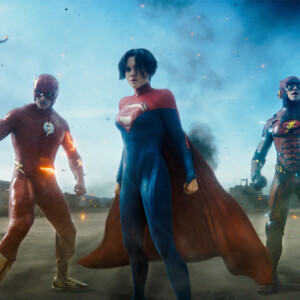How ILM Rammed A Hammerhead Corvette Into A Star Destroyer in ‘Rogue One’
Read how ILM gave one of the most popular vessels in Star Wars: Rebels the live-action treatment in Rogue One: A Star Wars Story.
In Rogue One, Admiral Raddus orders a Hammerhead Corvette to ram a Star Destroyer into the Shield Gate above the planet, Scarif. With the Shield Gate now disabled, Jyn Erso has an unobstructed path to transmit the Death Star plans from the planet below to Princess Leia’s ship.
The scene is one of the more crowd-pleasing moments during the climactic Battle of Scarif, giving fans of Star Wars: Rebels their first and–so far–only look at a “live-action” Hammerhead Corvette. Of course, live-action is a funny term to use for a completely cg spacecraft, and ILM employed modern technology to not only give the corvette realism, but also give the ship that old-fashioned Star Wars aesthetic.
“This movie is tied so closely to New Hope , [so] we wanted to capture the aesthetic using today’s techniques,” Rogue One Visual Effects Supervisor Nigel Sumner told Computer Graphics World.
Emulating That Old Star Wars Aesthetic
The idea of creating that old Star Wars aesthetic came from John Knoll, Rogue One’s executive producer and production visual effects supervisor. In particular, he wanted to digitize the “kitbashing” technique that special effects pioneer John Dykstra used on A New Hope. Kitbashing, is the use of pieces from commercial model kits to add surface details to models, such as spacecraft. Dykstra, faced with limited time, budget, and the technology of the day, took parts of World War II flak cannons, U.S. navy battleships, fighter planes, tanks and submarines from model kits to build Star Destroyers, X-Wings, TIE Fighters, and the Millennium Falcon.
Nearly forty years on, ILM found an old, intact model set (a remnant of those used in 1977) in the archives of Lucas Museum. This find gave Knoll the “digital kitbashing” idea. But one vintage model set wasn’t enough. “We had to buy a bunch of them off eBay,” said Knoll. From there, ILM scanned each piece digitally, building a library of more than 300 digital model set pieces. Then, each digital piece was individually applied to spacecraft to give surface detail. This “digital kitbashing” imbued the CG models of Star Destroyers, X Wings, TIE Fighters with a similar aesthetic to A New Hope, and simultaneously tied in craft, like the Hammerhead Corvette, which had only been seen previously in the animated show, Rebels.
A More Sophisticated Battle Sequence
In addition, digital techniques and advanced cameras gave new perspectives to the action. Here, the Hammerhead Corvette sequence is the standout example, taking the perspective inside the destruction of the Star Destroyer.
Knoll told FXGuide that attacks on Star Destroyers tend to follow a similar format culminating with an exterior shot of the ships exploding into a fireball. With this sequence, Knoll wanted to take the viewer’s perspective inside the Star Destroyer showing the collision and destruction of the Star Destroyers from the inside out. Not only did this give a new perspective to the action, but in the hands of animator Euisang Lee, the collision also helped with the pacing of the scene.
“What was cool about it was that Euisung animated the whole thing as one continuous piece of action, all the way from the Corvette coming in and hitting the side, pushing the Destroyers together, the collision etc,” Hal Hickel, ILM’s Character Animation Supervisor told FXGuide.
The team then put this ILM V-Cam set up on the motion capture stage, “where [director] Gareth [Edwards] could view it in 3D, from an iPad-like controller he holds in his hands, and he can walk around this long looping 30 – 40 second piece of action – and hunt for angles” explained Hickel. “Which is great because that is how he works with live action, walking with a camera hunting for angles on the action that they want.”
The V-Cam, is a virtual camera system developed by ILM, which allowed Edwards to show the camera angles he wanted instead of trying to describe them to ILM. The V-Cam gave ILM a visual representation of the scene, and left them no doubt on what the director wanted. For example, Edwards wanted to attach the virtual camera to the back of the Hammerhead corvette. “‘I want to ride along with it as it heads towards the Star Destroyer and [then you can] just give me pan and tilt control,’” Edwards told Hickel.
“That’s just his process,” said Hickel. “He just likes to walk around on set with the camera and find stuff, and we just wanted to give him the same opportunity with the digital scenes, so those shots had the same feeling of cinematography as the set pieces.”
The combination of “digital kitbashing” and virtual cameras prevented Rogue One’s space battle from feeling like a retread of A New Hope. But “digital kitbashing” also helped ground these more sophisticated camera angles and effects in that old Star Wars aesthetic. When the climatic Battle of Scarif in Rogue One and the beginning of A New Hope are viewed together they feel like they belong in the same time period. While Darth Vader’s slaughter of Rebel soldiers in the hallway sequence, and unused archival footage from A New Hope’s Red Squadron used in the Battle of Scarif certainly helps place Rogue One in the same time period, ILM’s use of “digital kitbashing” visually ties the two films together.


